Trading Income: Badges of Trade, Allowable Expenditure Analysis
VerifiedAdded on 2021/04/27
|20
|2145
|63
Homework Assignment
AI Summary
This document offers a detailed exploration of trading income, primarily focusing on the taxation of self-employed individuals or sole traders. It defines what constitutes a trade, referencing judicial decisions and the 'badges of trade' criteria established by the Royal Commission on the Taxation of Profits and Income, including the subject matter of the transaction, the length of ownership, frequency of transactions, supplementary work, circumstances of sale, motive, method of finance, and the existence of similar trading activities. The document also covers tax-adjusted trading profit, allowable and non-allowable expenditure, including items like subscriptions, charitable donations, appropriations, and capital assets. It delves into specific examples such as excessive salaries, interest, repairs versus improvements, and restrictions on car leasing costs based on CO2 emissions. The document provides practical examples and calculations to illustrate the application of these tax principles.

Trading income
• Self-employed/sole traders: individuals whose profits arise from a
trade, profession or vocation
• What constitutes a trade? This has been reviewed several times by
the Courts.
• In June 1955, the Royal Commission on the Taxation of Profits and
Income used these judicial decisions to establish what they
regarded to be the following main criteria in identifying the 'badges
of trade':
-1.The subject matter of the transaction; there are 3 reasons for
purchasing an asset:
1. For personal use – not subject to tax
2. As an investment – capital in nature and not subject to income tax
3. For resale at a profit (that constitutes a trade): therefore subject to income
tax
-
• Self-employed/sole traders: individuals whose profits arise from a
trade, profession or vocation
• What constitutes a trade? This has been reviewed several times by
the Courts.
• In June 1955, the Royal Commission on the Taxation of Profits and
Income used these judicial decisions to establish what they
regarded to be the following main criteria in identifying the 'badges
of trade':
-1.The subject matter of the transaction; there are 3 reasons for
purchasing an asset:
1. For personal use – not subject to tax
2. As an investment – capital in nature and not subject to income tax
3. For resale at a profit (that constitutes a trade): therefore subject to income
tax
-
Paraphrase This Document
Need a fresh take? Get an instant paraphrase of this document with our AI Paraphraser
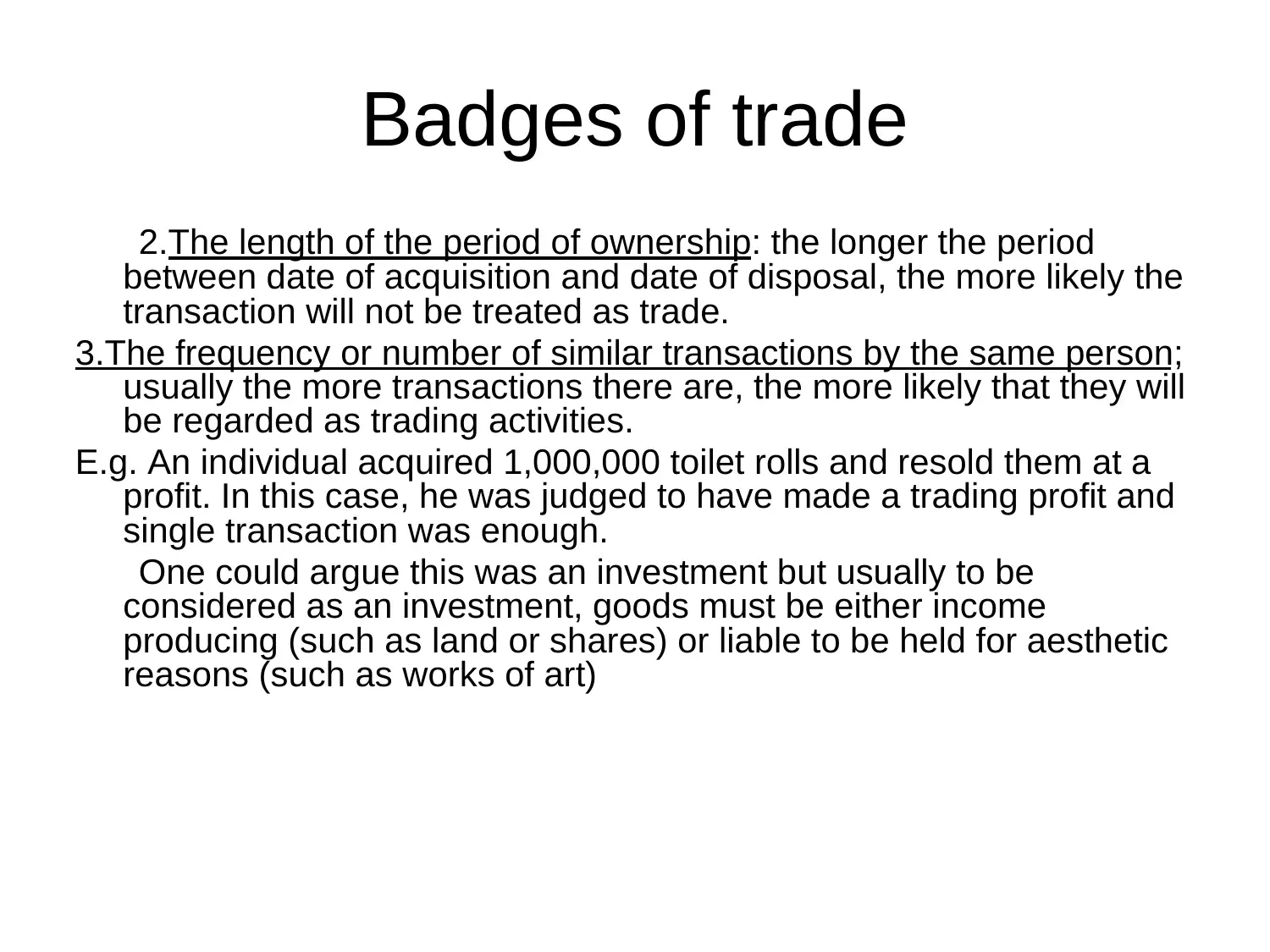
Badges of trade
2.The length of the period of ownership: the longer the period
between date of acquisition and date of disposal, the more likely the
transaction will not be treated as trade.
3.The frequency or number of similar transactions by the same person;
usually the more transactions there are, the more likely that they will
be regarded as trading activities.
E.g. An individual acquired 1,000,000 toilet rolls and resold them at a
profit. In this case, he was judged to have made a trading profit and
single transaction was enough.
One could argue this was an investment but usually to be
considered as an investment, goods must be either income
producing (such as land or shares) or liable to be held for aesthetic
reasons (such as works of art)
2.The length of the period of ownership: the longer the period
between date of acquisition and date of disposal, the more likely the
transaction will not be treated as trade.
3.The frequency or number of similar transactions by the same person;
usually the more transactions there are, the more likely that they will
be regarded as trading activities.
E.g. An individual acquired 1,000,000 toilet rolls and resold them at a
profit. In this case, he was judged to have made a trading profit and
single transaction was enough.
One could argue this was an investment but usually to be
considered as an investment, goods must be either income
producing (such as land or shares) or liable to be held for aesthetic
reasons (such as works of art)
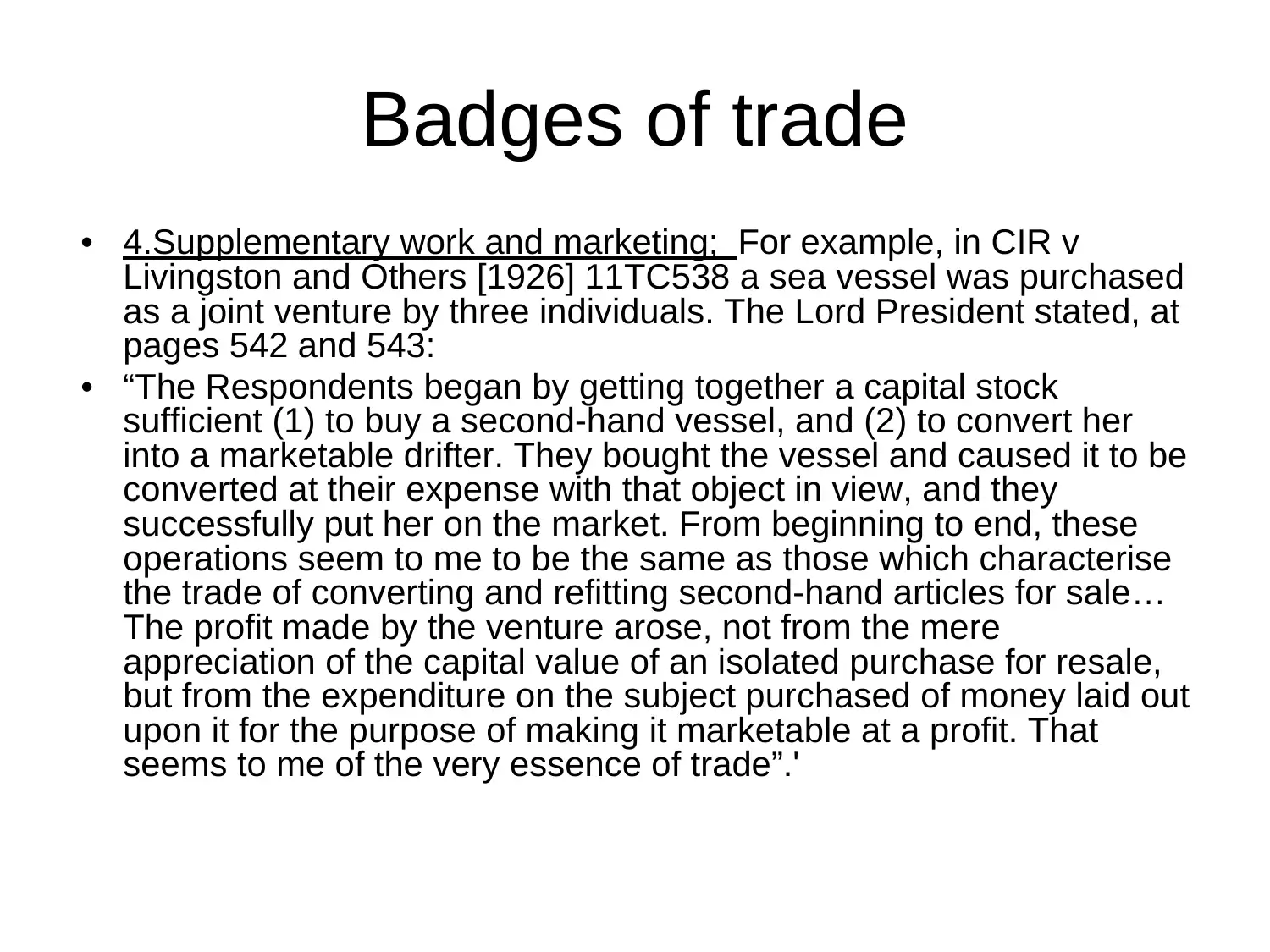
Badges of trade
• 4.Supplementary work and marketing; For example, in CIR v
Livingston and Others [1926] 11TC538 a sea vessel was purchased
as a joint venture by three individuals. The Lord President stated, at
pages 542 and 543:
• “The Respondents began by getting together a capital stock
sufficient (1) to buy a second-hand vessel, and (2) to convert her
into a marketable drifter. They bought the vessel and caused it to be
converted at their expense with that object in view, and they
successfully put her on the market. From beginning to end, these
operations seem to me to be the same as those which characterise
the trade of converting and refitting second-hand articles for sale…
The profit made by the venture arose, not from the mere
appreciation of the capital value of an isolated purchase for resale,
but from the expenditure on the subject purchased of money laid out
upon it for the purpose of making it marketable at a profit. That
seems to me of the very essence of trade”.'
• 4.Supplementary work and marketing; For example, in CIR v
Livingston and Others [1926] 11TC538 a sea vessel was purchased
as a joint venture by three individuals. The Lord President stated, at
pages 542 and 543:
• “The Respondents began by getting together a capital stock
sufficient (1) to buy a second-hand vessel, and (2) to convert her
into a marketable drifter. They bought the vessel and caused it to be
converted at their expense with that object in view, and they
successfully put her on the market. From beginning to end, these
operations seem to me to be the same as those which characterise
the trade of converting and refitting second-hand articles for sale…
The profit made by the venture arose, not from the mere
appreciation of the capital value of an isolated purchase for resale,
but from the expenditure on the subject purchased of money laid out
upon it for the purpose of making it marketable at a profit. That
seems to me of the very essence of trade”.'
⊘ This is a preview!⊘
Do you want full access?
Subscribe today to unlock all pages.

Trusted by 1+ million students worldwide
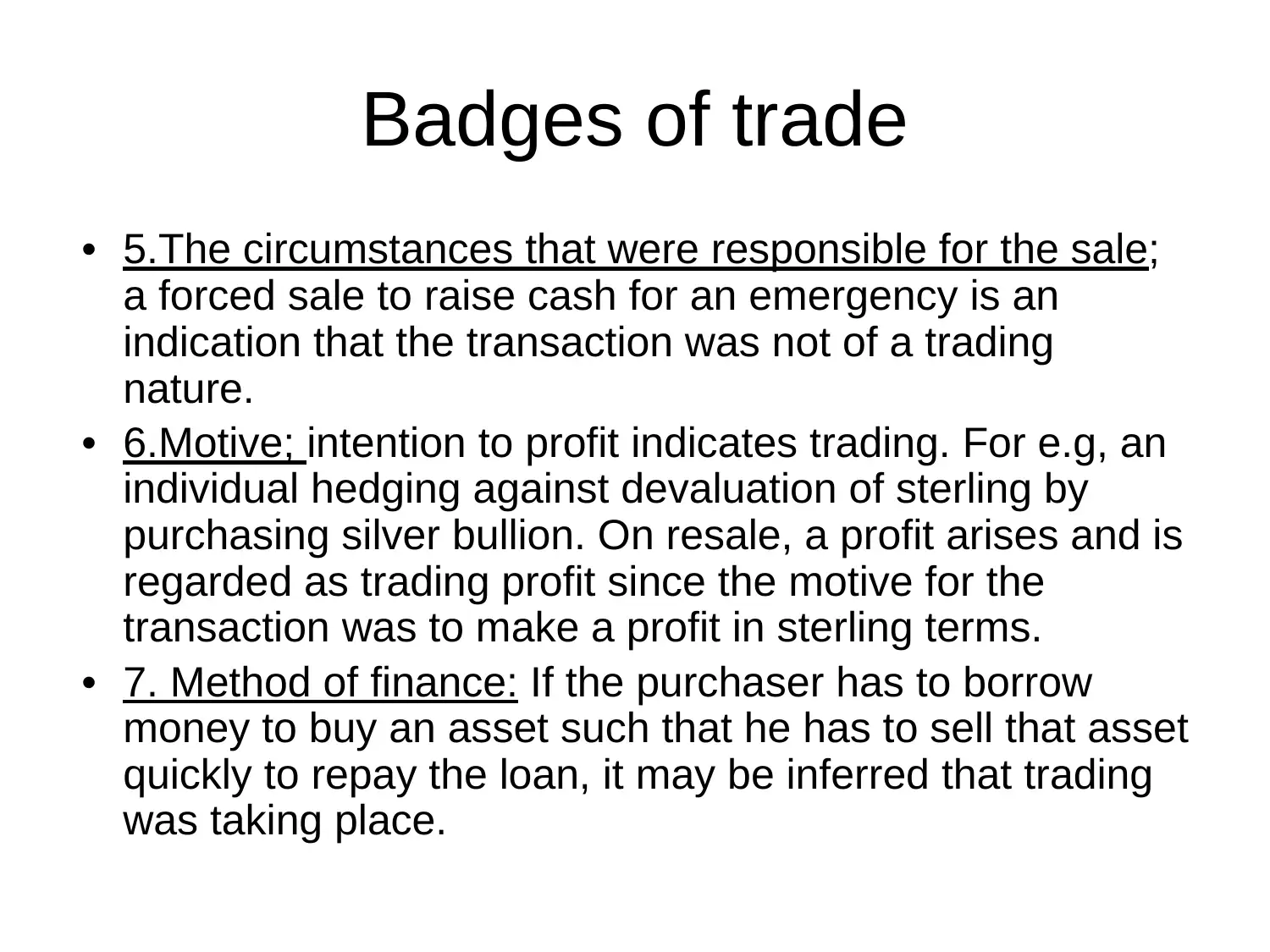
Badges of trade
• 5.The circumstances that were responsible for the sale;
a forced sale to raise cash for an emergency is an
indication that the transaction was not of a trading
nature.
• 6.Motive; intention to profit indicates trading. For e.g, an
individual hedging against devaluation of sterling by
purchasing silver bullion. On resale, a profit arises and is
regarded as trading profit since the motive for the
transaction was to make a profit in sterling terms.
• 7. Method of finance: If the purchaser has to borrow
money to buy an asset such that he has to sell that asset
quickly to repay the loan, it may be inferred that trading
was taking place.
• 5.The circumstances that were responsible for the sale;
a forced sale to raise cash for an emergency is an
indication that the transaction was not of a trading
nature.
• 6.Motive; intention to profit indicates trading. For e.g, an
individual hedging against devaluation of sterling by
purchasing silver bullion. On resale, a profit arises and is
regarded as trading profit since the motive for the
transaction was to make a profit in sterling terms.
• 7. Method of finance: If the purchaser has to borrow
money to buy an asset such that he has to sell that asset
quickly to repay the loan, it may be inferred that trading
was taking place.
Paraphrase This Document
Need a fresh take? Get an instant paraphrase of this document with our AI Paraphraser

Badges of trade
• 8. Existence of similar trading transactions or interests
If there is an existing trade, then a similarity to the
transaction which is being considered may point to that
transaction having a trading character. For e.g, a builder
who builds and sells a number of houses may be held to
be trading even if he retains one or more houses for
longer than usual and claims that they were held as an
investment
• Tax adjusted trading profit: the net profit per the financial
accounts often different from taxable trading profit figure.
Adjustments need to be made.
• 8. Existence of similar trading transactions or interests
If there is an existing trade, then a similarity to the
transaction which is being considered may point to that
transaction having a trading character. For e.g, a builder
who builds and sells a number of houses may be held to
be trading even if he retains one or more houses for
longer than usual and claims that they were held as an
investment
• Tax adjusted trading profit: the net profit per the financial
accounts often different from taxable trading profit figure.
Adjustments need to be made.
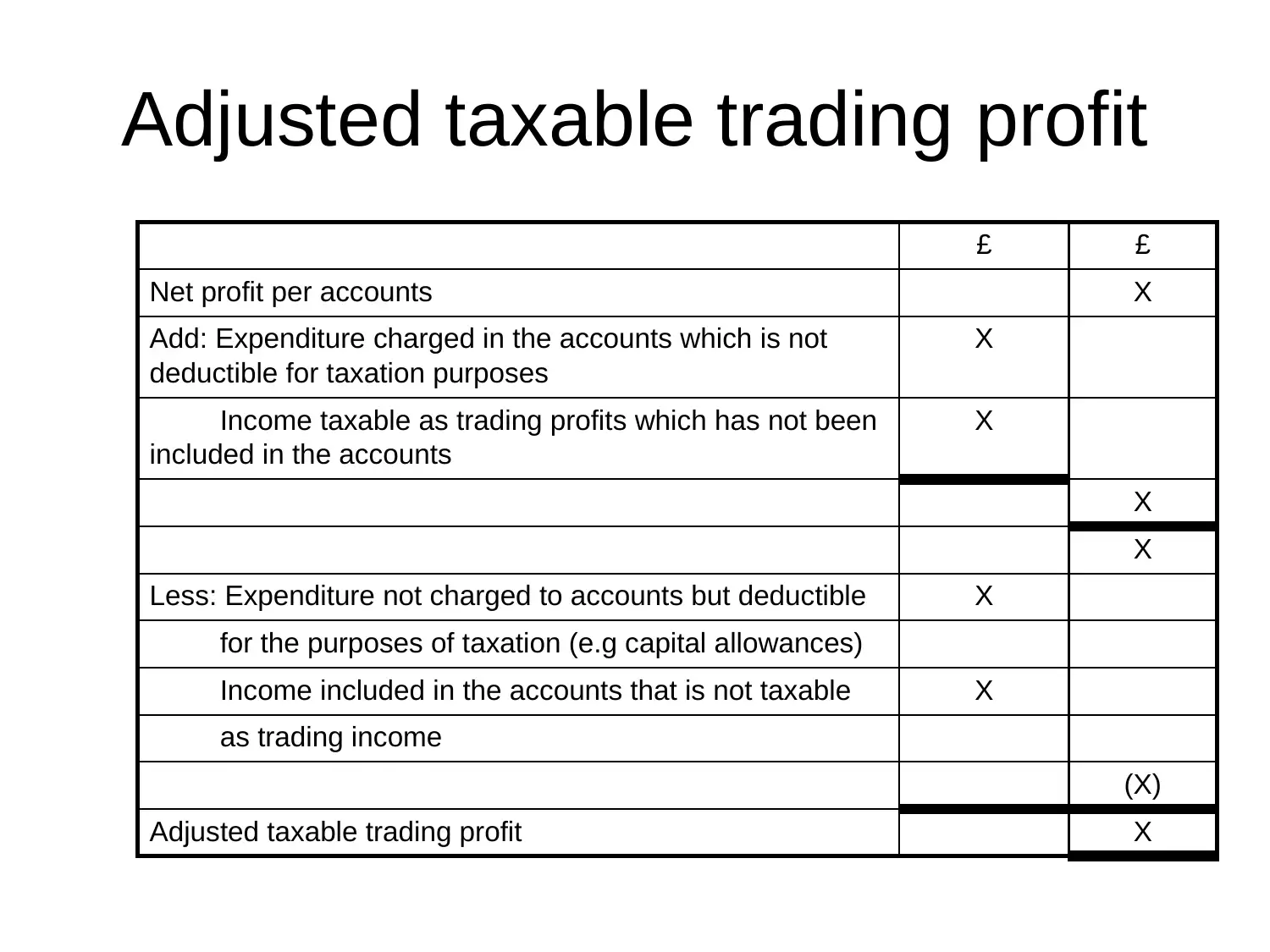
Adjusted taxable trading profit
£ £
Net profit per accounts X
Add: Expenditure charged in the accounts which is not
deductible for taxation purposes
X
Income taxable as trading profits which has not been
included in the accounts
X
X
X
Less: Expenditure not charged to accounts but deductible X
for the purposes of taxation (e.g capital allowances)
Income included in the accounts that is not taxable X
as trading income
(X)
Adjusted taxable trading profit X
£ £
Net profit per accounts X
Add: Expenditure charged in the accounts which is not
deductible for taxation purposes
X
Income taxable as trading profits which has not been
included in the accounts
X
X
X
Less: Expenditure not charged to accounts but deductible X
for the purposes of taxation (e.g capital allowances)
Income included in the accounts that is not taxable X
as trading income
(X)
Adjusted taxable trading profit X
⊘ This is a preview!⊘
Do you want full access?
Subscribe today to unlock all pages.

Trusted by 1+ million students worldwide
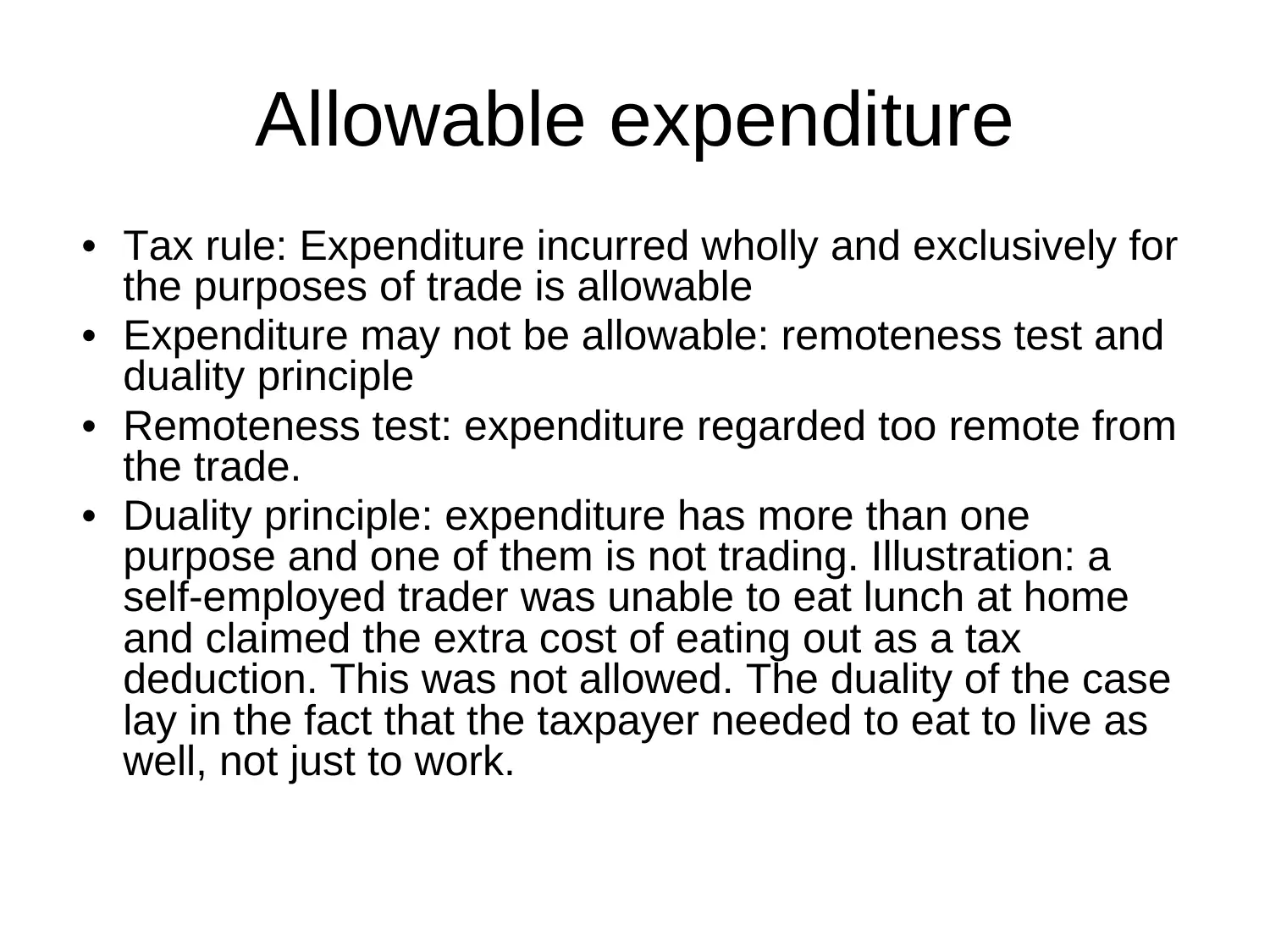
Allowable expenditure
• Tax rule: Expenditure incurred wholly and exclusively for
the purposes of trade is allowable
• Expenditure may not be allowable: remoteness test and
duality principle
• Remoteness test: expenditure regarded too remote from
the trade.
• Duality principle: expenditure has more than one
purpose and one of them is not trading. Illustration: a
self-employed trader was unable to eat lunch at home
and claimed the extra cost of eating out as a tax
deduction. This was not allowed. The duality of the case
lay in the fact that the taxpayer needed to eat to live as
well, not just to work.
• Tax rule: Expenditure incurred wholly and exclusively for
the purposes of trade is allowable
• Expenditure may not be allowable: remoteness test and
duality principle
• Remoteness test: expenditure regarded too remote from
the trade.
• Duality principle: expenditure has more than one
purpose and one of them is not trading. Illustration: a
self-employed trader was unable to eat lunch at home
and claimed the extra cost of eating out as a tax
deduction. This was not allowed. The duality of the case
lay in the fact that the taxpayer needed to eat to live as
well, not just to work.
Paraphrase This Document
Need a fresh take? Get an instant paraphrase of this document with our AI Paraphraser
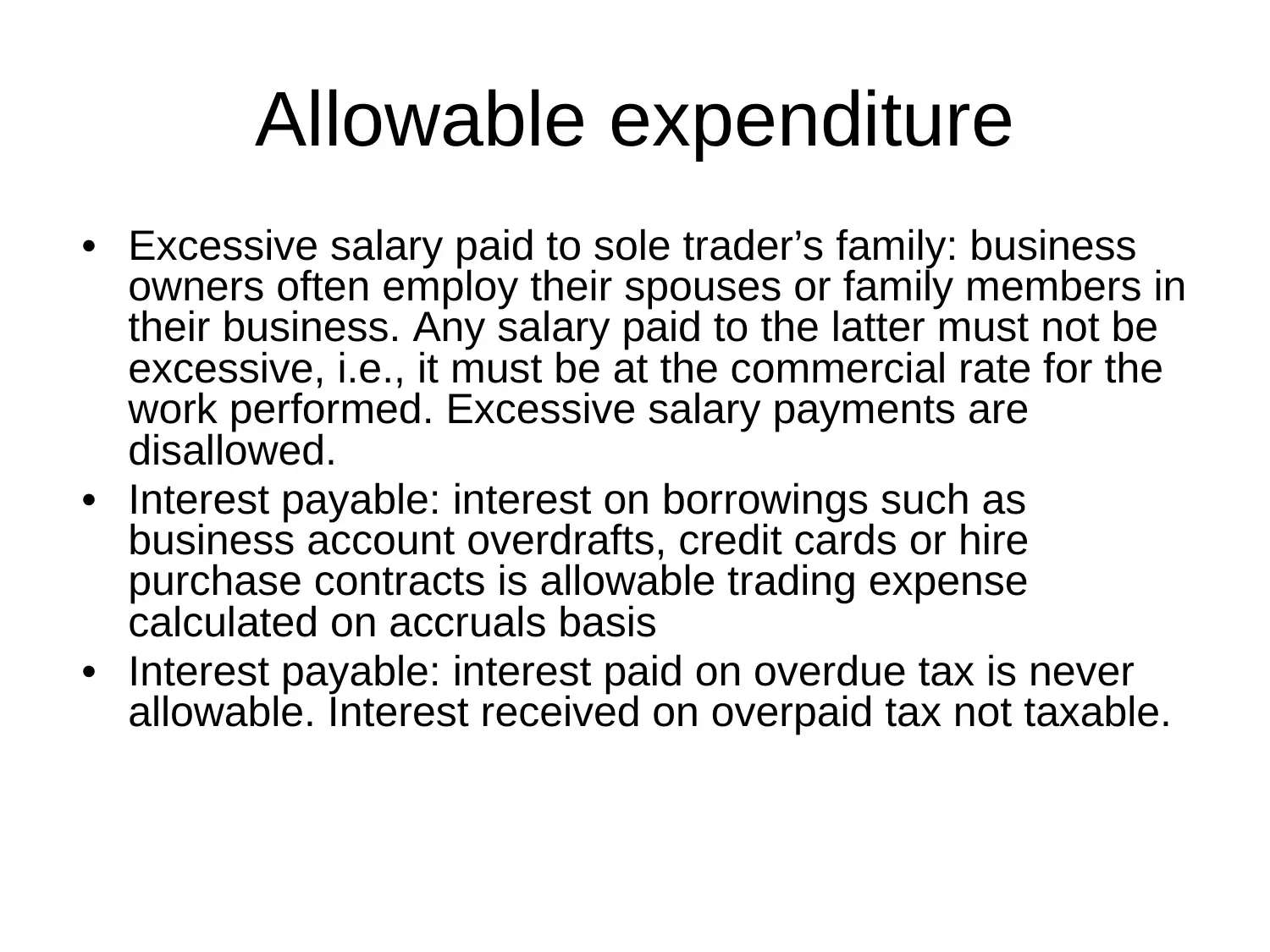
Allowable expenditure
• Excessive salary paid to sole trader’s family: business
owners often employ their spouses or family members in
their business. Any salary paid to the latter must not be
excessive, i.e., it must be at the commercial rate for the
work performed. Excessive salary payments are
disallowed.
• Interest payable: interest on borrowings such as
business account overdrafts, credit cards or hire
purchase contracts is allowable trading expense
calculated on accruals basis
• Interest payable: interest paid on overdue tax is never
allowable. Interest received on overpaid tax not taxable.
• Excessive salary paid to sole trader’s family: business
owners often employ their spouses or family members in
their business. Any salary paid to the latter must not be
excessive, i.e., it must be at the commercial rate for the
work performed. Excessive salary payments are
disallowed.
• Interest payable: interest on borrowings such as
business account overdrafts, credit cards or hire
purchase contracts is allowable trading expense
calculated on accruals basis
• Interest payable: interest paid on overdue tax is never
allowable. Interest received on overpaid tax not taxable.

Allowable expenditure
• Subscriptions:
– Trade or professional association subscriptions normally
deductible since they will be made wholly and exclusively for the
purposes of the trade
• Charitable donations: to be allowable, expenses must
be: • Wholly and exclusively for trading purposes
• Local and reasonable in size in relation to the business making the
donation
• Made to an educational, religious, cultural, recreational or
benevolent organisation
• If donation is disallowed but payment was made to a charity, the
taxpayer can claim relief under Gift Aid Scheme
• Subscriptions and donations to political parties are not
deductible
• Subscriptions:
– Trade or professional association subscriptions normally
deductible since they will be made wholly and exclusively for the
purposes of the trade
• Charitable donations: to be allowable, expenses must
be: • Wholly and exclusively for trading purposes
• Local and reasonable in size in relation to the business making the
donation
• Made to an educational, religious, cultural, recreational or
benevolent organisation
• If donation is disallowed but payment was made to a charity, the
taxpayer can claim relief under Gift Aid Scheme
• Subscriptions and donations to political parties are not
deductible
⊘ This is a preview!⊘
Do you want full access?
Subscribe today to unlock all pages.

Trusted by 1+ million students worldwide
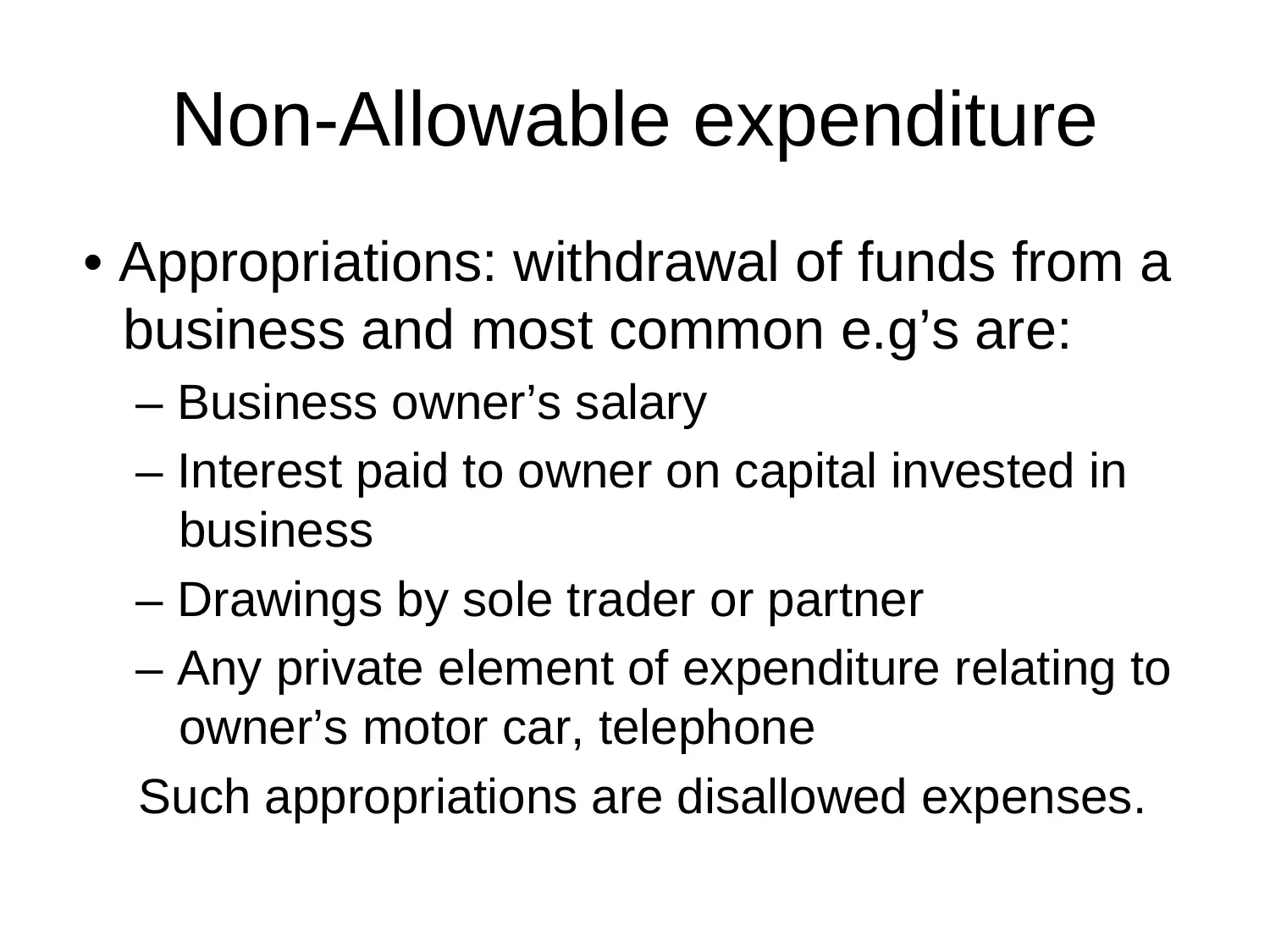
Non-Allowable expenditure
• Appropriations: withdrawal of funds from a
business and most common e.g’s are:
– Business owner’s salary
– Interest paid to owner on capital invested in
business
– Drawings by sole trader or partner
– Any private element of expenditure relating to
owner’s motor car, telephone
Such appropriations are disallowed expenses.
• Appropriations: withdrawal of funds from a
business and most common e.g’s are:
– Business owner’s salary
– Interest paid to owner on capital invested in
business
– Drawings by sole trader or partner
– Any private element of expenditure relating to
owner’s motor car, telephone
Such appropriations are disallowed expenses.
Paraphrase This Document
Need a fresh take? Get an instant paraphrase of this document with our AI Paraphraser

Non-Allowable expenditure
• Expenditure on capital assets not allowable.
• Expenditure on P&M attracts capital allowances (to be
covered later)
• Legal cases have shown the following in respect of
repair (revenue) versus improvement (capital)
expenditure:
1. Cost of initial repairs in order to make an asset
usable is not deductible
2. Cost of initial repairs is deductible if asset can be put
into use before any repairs are carried out
3. To be allowable, it needs to be proven that the
restoration renews a subsidiary part of an asset. For
e.g the replacement of an old stand with a new one at
a football club was held to be expenditure on a new
asset and thus capital expenditure.
• Expenditure on capital assets not allowable.
• Expenditure on P&M attracts capital allowances (to be
covered later)
• Legal cases have shown the following in respect of
repair (revenue) versus improvement (capital)
expenditure:
1. Cost of initial repairs in order to make an asset
usable is not deductible
2. Cost of initial repairs is deductible if asset can be put
into use before any repairs are carried out
3. To be allowable, it needs to be proven that the
restoration renews a subsidiary part of an asset. For
e.g the replacement of an old stand with a new one at
a football club was held to be expenditure on a new
asset and thus capital expenditure.
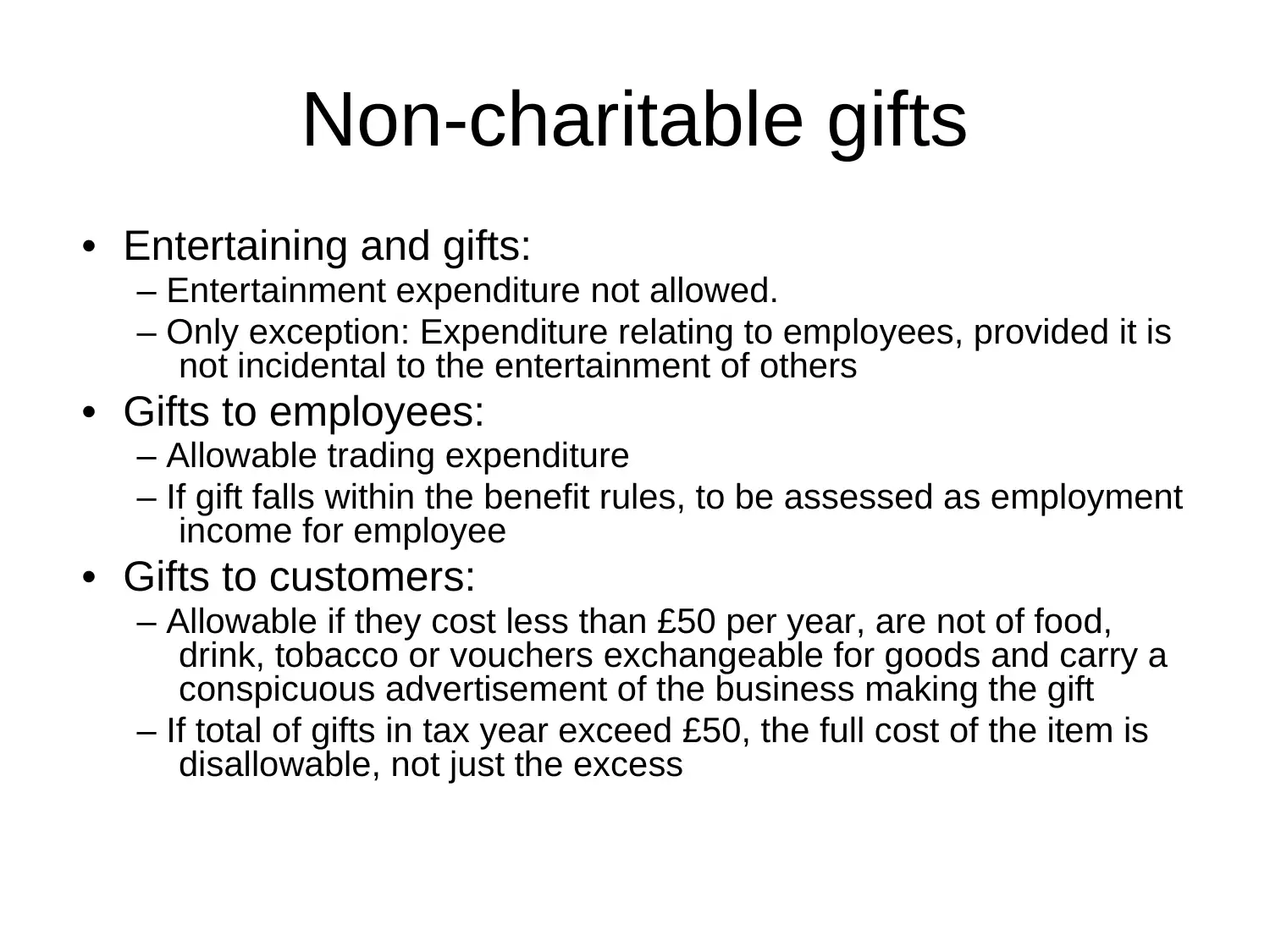
Non-charitable gifts
• Entertaining and gifts:
– Entertainment expenditure not allowed.
– Only exception: Expenditure relating to employees, provided it is
not incidental to the entertainment of others
• Gifts to employees:
– Allowable trading expenditure
– If gift falls within the benefit rules, to be assessed as employment
income for employee
• Gifts to customers:
– Allowable if they cost less than £50 per year, are not of food,
drink, tobacco or vouchers exchangeable for goods and carry a
conspicuous advertisement of the business making the gift
– If total of gifts in tax year exceed £50, the full cost of the item is
disallowable, not just the excess
• Entertaining and gifts:
– Entertainment expenditure not allowed.
– Only exception: Expenditure relating to employees, provided it is
not incidental to the entertainment of others
• Gifts to employees:
– Allowable trading expenditure
– If gift falls within the benefit rules, to be assessed as employment
income for employee
• Gifts to customers:
– Allowable if they cost less than £50 per year, are not of food,
drink, tobacco or vouchers exchangeable for goods and carry a
conspicuous advertisement of the business making the gift
– If total of gifts in tax year exceed £50, the full cost of the item is
disallowable, not just the excess
⊘ This is a preview!⊘
Do you want full access?
Subscribe today to unlock all pages.

Trusted by 1+ million students worldwide
1 out of 20
Your All-in-One AI-Powered Toolkit for Academic Success.
+13062052269
info@desklib.com
Available 24*7 on WhatsApp / Email
![[object Object]](/_next/static/media/star-bottom.7253800d.svg)
Unlock your academic potential
Copyright © 2020–2025 A2Z Services. All Rights Reserved. Developed and managed by ZUCOL.

